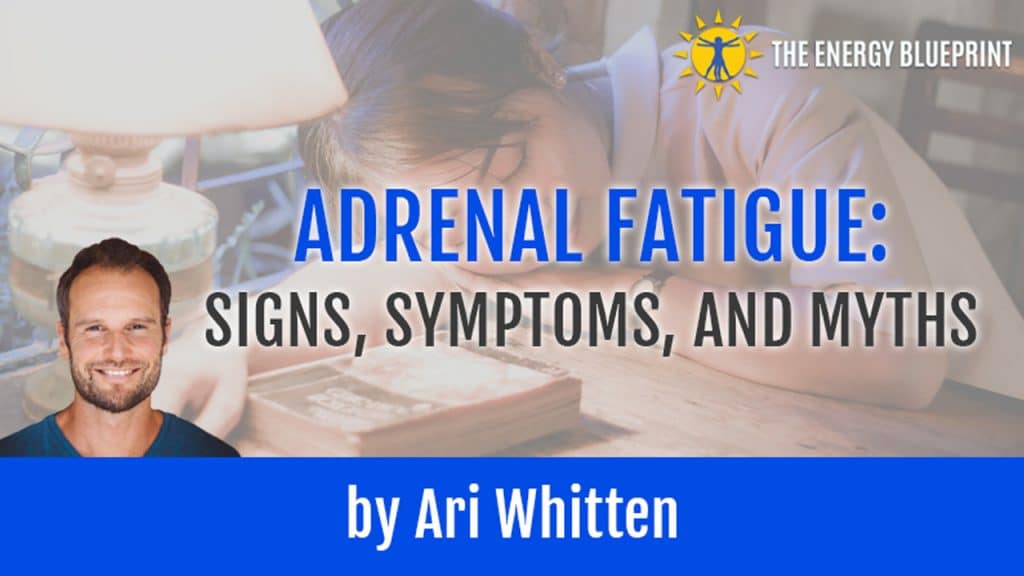Adrenal Fatigue is a term applied to a set of non-specific symptoms that include fatigue and extreme tiredness, weak immune system, depression, anxiety, brain fog, low blood sugar, low libido, waking up tired even after 7 or 8 hours of sleep, cravings for sugary or salty foods and trouble sleeping through the night (especially waking up between 2-4am). Though Adrenal Fatigue appears in popular functional medicine books and alternative medicine circles, there is little evidence to support its existence and it is not accepted as a legitimate medical condition.
Background of Adrenal Glands
The theory behind Adrenal Fatigue is largely based on the work of researcher Hans Selye who proposed that the body goes through 3 phases when exposed to chronic stress ultimately leading to shut down or system-wide failure. The 3 phases are generally described as follows:
1) Alarm reaction – the body’s initial response to heightened stress levels(fight or flight), which involves the adrenal glands producing lots of cortisol.
2) Resistance – Long term stress or when stress is prolonged, the adrenal glands struggle to keep up with cortisol production and levels may be normal or high.
3) Exhaustion – at this stage the adrenals are “fatigued” and can no longer produce enough cortisol to keep up with demands and Cortisol levels dip.
Though this might sound logical there is no evidence to support this theory. In fact, the Endocrine Society (which represents 14,000 endocrinologists) has put out a public statement that reads:
“‘Adrenal Fatigue’ is not a real medical condition. There are no scientific facts to support the theory that long-term mental, emotional, or physical stress drains the adrenal glands and causes many common symptoms.”
In an exhaustive study of all the research related to chronic stress and Cortisol levels it was found that there was no correlation between the two. The majority of studies show no significant differences in levels between people experiencing high vs low stress. There is no clear pattern of chronic stress being associated with low Cortisol levels. Even when disorders such as Burnout Syndrome, Vital Exhaustion (or Exhaustion Disorder) and Chronic Fatigue Syndrome/Fibromyalgia (which have very similar symptoms to Adrenal Fatigue) were studied, it was found that these disorders were NOT reliably associated with low Cortisol levels. Some studies show slightly higher cortisol 1 2, some show lower 3 4 and some show no difference 5 6 7.
If anything, the overall literature shows that both acute and chronic stress is characterized by higher (not lower) cortisol levels 8. For an in-depth examination on the literature on how different chronic stressors affect levels see “Debunking Adrenal Fatigue”
Recent prospective cohort studies also suggest that “there are no HPA axis* changes present during the early stages of the genesis of fatiguing illnesses” 9, thus confirming that it cannot be the cause. The same study also suggests “a reversed direction of causation (ie that the illness leads to HPA axis change rather that the other way around) is supported by the findings that there is an apparent absence of HPA Axis changes early in the genesis of chronic fatigue states, and that modifying cognitive behavioral components of the illness leads to normalization of the HPA axis.” 10
Symptoms of Adrenal Fatigue
- weight gain
- lack of sex drive
- lightheadedness
- craving salt and sugar
- bone loss/osteoporosis
- poor immune function
- sleep problems/insomnia
- acne and other skin problems
Cortisol abnormalities that do occur in a subset of people with chronic fatigue can easily be explained by lifestyle and behavioral factors such as inactivity, sleep disturbances, psychiatric comorbidity, medication and stress. One study concluded that “the changes observed in CFS may be secondary to disrupted sleep and social routine, and thus an epiphenomenon** in terms of fatigue causation.” 11
You can read a comprehensive debunking of the idea of adrenal fatigue by reading the article “Is Adrenal Fatigue Real?”
What is Adrenal Insufficiency
Though a blood test is not a valid way of assessing symptoms of adrenal fatigue, it is useful for ruling out legitimate medical conditions such as Addison’s Disease (also called Adrenal Insufficiency), in which there is a pattern of high ACTH and low levels (which indicates that the brain is directing the adrenals to release more Cortisol but the adrenals are unable to produce enough).
Addison’s disease occurs in all age groups and both sexes, and can be life-threatening. Signs and symptoms include: extreme fatigue, weight loss and decreased appetite, darkening of your skin (hyperpigmentation), low blood pressure, fainting, salt craving, low blood sugar (hypoglycemia), nausea, diarrhea or vomiting (gastrointestinal symptoms), abdominal pain, muscle or joint pains, irritability, depression and body hair loss or sexual dysfunction in women. 12 Treatment for Addison’s Disease involves taking hormones to replace those that are missing.
Other Potential Causes of Fatigue

Symptoms such as being tired, lacking energy, and sleeping all day long could be signs of depression 13, fibromyalgia, or any number of diseases. In addition, low morning Cortisol could be due to a flattened diurnal curve of Cortisol, whereby less Cortisol is produced in the morning and more produced in the night. This occurs for a number of reasons including:
- Staying up late at night (ie. being a night owl) 14 15 16
- Lack of morning light exposure 17 18 19
- Night eating 20
- Being overweight 21
- Nutrient deficiencies (including deficiencies of Vitamin C, B Vitamins, Folic Acid, Panthenoic Acid, Biotin, Calcium, Potassium, Zinc and Iron) which can be corrected with multivitamin supplements 22
- Rumination and neuroticism (which both contribute to depression 23
- Helplessness, hopelessness and low self-esteem 24 25
- Cynicism 26
- Taking certain medications, such as anti-depressants 27, Aspirin 28, Tylenol (acetominaphen) 29, Opiods 30 and some blood pressure lowering drugs 31
- Recent loss of a partner and/or social isolation 32
- Ethnicity – African Americans and Hispanics tend to have lower morning Cortisol levels than Caucasians 33
- Low physical activity levels 34
- Anticipation of a low stress day/vacation 35
- Lower socioeconomic status 36
- Psychological trauma or PTSD (post-traumatic stress disorder) 37
- Genetics – different groups of people have different baseline cortisol levels that can be inherited 38 39
- Toxins – such as glyphosphates, fungicides, BPA found in plastics and heavy metals have been shown to interfere with blood cortisol levels 40 41 42
- Inflammation – resulting from oxidative stress can cause the body to intentionally suppress Cortisol levels 43
- Poor sleep 44 45 – this can be from not insufficient sleep duration or quality (resulting from conditions such as sleep apnea) or simply from poor circadian rhythm and sleep hygiene habits that result in poor sleep efficiency.
This shows that Cortisol output changes dynamically with whats going on day-to-day and is not a stable diagnostic of “adrenal fatigue”. Morning Cortisol is most influenced by sleep quality and duration and one study concluded that “Neuroendocrine abnormalities (ie low morning Cortisol) reported to be characteristic of Chronic Fatigue Syndrome may be merely the consequence of disrupted sleep and social routine.” 46
In essence, if you do have low levels (as shown from a valid test) you can fix the factors that cause low morning cortisol and improve your symptoms!
Conclusion
In conclusion, it can be said that there is no evidence to explain the cause of chronic fatigue through the theory of adrenal exhaustion or low cortisol levels and if we are going to find effective answers to chronic fatigue, we must let go of these outdated theories and look for alternative causes.
* the HPA Axis refers to the important hormonal response system—the hypothalamic–pituitary–adrenal (HPA) axis—which produces the stress hormones known as glucocorticoids and primarily cortisol. The action of this hormone system is to tightly regulate the body’s response to stress and bring it back to homeostasis.
** a secondary symptom, occurring simultaneously with a disease or condition but not directly related to it.
References[+]
| ↑1 | Melamed S. et al. (1999) “Chronic burnout, somatic arousal and elevated salivary cortisol levels.” |
|---|---|
| ↑2 | De Vente W., et al. (2003) “Physiological differences between burnout patients and healthy controls: blood pressure, heart rate and cortisol responses.” |
| ↑3 | Sonnenschein M., (2007) Exhaustion and endocrine functioning in clinical burnout.” |
| ↑4 | Juster RP., et al (2010) A clinical allostatic load index is associated with burnout symptoms and hypocortisolemic profiles in healthy workers.” |
| ↑5 | Rahman K., et al. (2011) Sleep-Wake Behavior in Chronic Fatigue Syndrome.” |
| ↑6 | Lennartsson AK., et al (2015) Burnout and hypocortisolism – a matter of severity? A study on ACTH and cortisol responses to acute psychosocial stress.” |
| ↑7 | Mommersteeg PMC., et al (2005) “Clinical burnout is not reflected in cortisol awakening response, the day-curve or the response to low-dose dexamethasone suppression test.” |
| ↑8 | Chida, Y. et al., (2009) “Cortisol Awakening Response and Psychosocial Factors: A Systematic Review and Meta-Analysis.” |
| ↑9 | Cleare AJ. (2003) “The HPA Axis and the genesis of Chronic Fatigue.” |
| ↑10 | Blockmans D., et al. (2003) “Combination therapy with hydrocortisone and fludrocortisone does not improve symptoms in chronic fatigue syndrome: a randomized, placebo-controlled, double-blind, crossover study.” |
| ↑11 | Parker AJR., et al. (2001) “The neuroendocrinology of chronic fatigue syndrome and fibromyalgia.” |
| ↑12 | https://www.mayoclinic.org/diseases-conditions/addisons-disease/symptoms-causes/syc-20350293 |
| ↑13, ↑23 | Hsiao, FH., et. al., (2010) “The self-perceived symptom distress and health-related conditions associated with morning to evening diurnal cortisol patterns in outpatients with major depressive disorder.” Psychoneuroendocrinology, Volume 35, Issue 4, May 2010, Pages 503-515 |
| ↑14 | Abbruzzese EA., et al. (2014) “The Influence Of The Chronotype On The Awakening Response Of Cortisol In The Morning.” |
| ↑15 | Oginska H., et al. (2010) “Chronotype, sleep loss, and diurnal pattern of salivary cortisol in a simulated daylong driving.” |
| ↑16 | BM Kudielka et al. (2005) “Morningness and Eveningness: The Free Cortisol Rise After Awakening in “Early Birds” and “Night Owls”.” |
| ↑17 | Thorn, L,. et. al. (2011) “Seasonal differences in the diurnal pattern of cortisol secretion in healthy participants and those with self-assessed seasonal affective disorder.” Psychoneuroendocrinology, Volume 36, Issue 6, July 2011, Pages 816-823 |
| ↑18 | Gabel, V., et. al., (2013) “Effects of Artificial Dawn and Morning Blue Light on Daytime Cognitive Performance, Well-being, Cortisol and Melatonin Levels.” The Journal of Biological and Medical Rhythm Research, Volume 30, 2013 – Issue 8 |
| ↑19 | Figueiro, MG., et. al., (2012) “Short-Wavelength Light Enhances Cortisol Awakening Response in Sleep-Restricted Adolescents.” International Journal of Endocrinology, Volume 2012, Article ID 301935, 7 pages |
| ↑20 | Goel, N., et. al. (2009) “Circadian Rhythm Profiles in Women with Night Eating Syndrome.” J Biol Rhythms. 2009 Feb; 24(1): 85–94. doi: 10.1177/0748730408328914 |
| ↑21 | Champaneri, S MD et al. (2013) “Diurnal Salivary Cortisol is Associated With Body Mass Index and Waist Circumference: The Multi-Ethnic Study of Atherosclerosis.” |
| ↑22 | Camfield, DA., et. al., (2013) “The Effects of Multivitamin Supplementation on Diurnal Cortisol Secretion and Perceived Stress, Nutrients.” 2013 Nov; 5(11): 4429–4450. Published online 2013 Nov 11. doi: 10.3390/nu5114429 |
| ↑24 | Hauner, KKY., et. al., “Neuroticism and Introversion are Associated with Salivary Cortisol Patterns in Adolescents, Psychoneuroendocrinology.” 2008 Nov; 33(10): 1344–1356. Published online 2008 Sep 21. doi: 10.1016/j.psyneuen.2008.07.011 |
| ↑25 | Zilioli, S., et. al., (2016) “Childhood Adversity, Self-Esteem, and Diurnal Cortisol Profiles across the Lifespan.” Psychol Sci. 2016 Sep; 27(9): 1249–1265. Published online 2016 Aug 1. doi: 10.1177/0956797616658287 |
| ↑26 | Sjogren, E., et. al., (2006) “Diurnal saliva cortisol levels and relations to psychosocial factors in a population sample of middle-aged swedish men and women.” International Journal of Behavioral Medicine, September 2006, Volume 13, Issue 3, pp 193–200 |
| ↑27 | Sjörs A., et al. “Long-term follow-up of cortisol awakening response in patients treated for stress-related exhaustion.” |
| ↑28 | Nye, EJ., et al., (1997) “Aspirin Inhibits Vasopressin-Induced Hypothalamic-Pituitary-Adrenal Activity in Normal Humans.” The Journal of Clinical Endocrinology & Metabolism, Volume 82, Issue 3, 1 March 1997, Pages 812–817 |
| ↑29 | Oskarsson A, et al., “Acetaminophen Increases Aldosterone Secretion While Suppressing Cortisol and Androgens: A Possible Link to Increased Risk of Hypertension.” Am J Hypertens. 2016 Oct;29(10):1158-64. doi: 10.1093/ajh/hpw055. Epub 2016 May 23. |
| ↑30 | Lee, AS., et al., (2015) “Opioid-induced secondary adrenal insufficiency presenting as hypercalcaemia.” Endocrinol Diabetes Metab Case Rep. 2015; 2015: 150035. |
| ↑31 | Dart, AM., et al., (1981) “The effect of chronic propranolol treatment on Overnight plasma levels of anterior pituitary and Related hormones.” Departments of Cardiology and Pharmacology, Welsh National School of Medicine and Tenovus Institute for Cancer Research, Cardiff |
| ↑32 | Doane, LD., et. al., (2009) “Loneliness and Cortisol: Momentary, Day-to-day, and Trait Associations,” Psychoneuroendocrinology. 2010 Apr; 35(3): 430–441. Published online 2009 Sep 9. doi: 10.1016/j.psyneuen.2009.08.005 |
| ↑33, ↑36 | Hajat, A., et. al., (2010) “Socioeconomic and race/ethnic differences in daily salivary cortisol profiles: The Multi-Ethnic Study of Atherosclerosis.” Psychoneuroendocrinology. 2010 Jul; 35(6): 932–943. Published online 2010 Jan 29. doi: 10.1016/j.psyneuen.2009.12.009 |
| ↑34 | Tryon WW, et al. (2004) “Chronic fatigue syndrome impairs circadian rhythm of activity level.” |
| ↑35 | Fries E., et al. (2008) “The cortisol awakening response (CAR): Facts and future directions.” |
| ↑37 | Shahili Jain, (2016) “Cortisol, the Intergenerational Transmission of Stress, and PTSD: An Interview With Dr. Rachel Yehuda.” |
| ↑38 | Genetics Home Reference, Familial glucocorticoid deficiency |
| ↑39 | Genetics Home Reference, 21-hydroxylase deficiency |
| ↑40 | Sanderson, T.J. (2006) “The steroid hormone Biosynthesis pathway as a target for endocrine-disrupting chemicals.” Toxicological Sciences, 94(1), pp. 21–3. doi: 10.1093/toxsci/kfl051. |
| ↑41 | Panagiotidou, E., Zerva, S., Mitsiou, D.J., Alexis, M.N., Kitraki, E. and ekitraki (2014) “Perinatal exposure to low-dose bisphenol A affects the neuroendocrine stress response in rats.” Journal of Endocrinology, 220(3), pp. 207–218. doi: 10.1530/JOE-13-0416. |
| ↑42 | Dyer, C.A. (2007) “Heavy metals as endocrine-disrupting chemicals”, in Endocrine-Disrupting Chemicals. Springer Nature, pp. 111–133. |
| ↑43 | Morris, G., et. al., (2017) “Hypothalamic-Pituitary-Adrenal Hypofunction in Myalgic Encephalomyelitis (ME)/Chronic Fatigue Syndrome (CFS) as a Consequence of Activated Immune-Inflammatory and Oxidative and Nitrosative Pathways.” Mol Neurobiol. 2017 Nov;54(9):6806-6819. doi: 10.1007/s12035-016-0170-2. Epub 2016 Oct 20. |
| ↑44 | Bozic, L., et. al., (2016) “Morning cortisol levels and glucose metabolism parameters in moderate and severe obstructive sleep apnea patients.” Endocrine. 2016 Sep;53(3):730-9. doi: 10.1007/s12020-016-0925-6. Epub 2016 Mar 21. |
| ↑45 | Tell D., et al. (2014) “Day-to-day dynamics of associations between sleep, napping, fatigue, and the cortisol diurnal rhythm in women diagnosed as having breast cancer.” |
| ↑46 | Leese G., et al. (1996) “Short-term night-shift working mimics the pituitary-adrenocortical dysfunction in chronic fatigue syndrome.” |





